
All images © by Roberto Piperno, owner of the domain. Write to romapip@quipo.it.
Notes:
Page revised in August 2021.

All images © by Roberto Piperno, owner of the domain. Write to romapip@quipo.it.
Notes:
Page revised in August 2021.
 - Avignon
- AvignonYou may wish to see an introductory page to this section first.
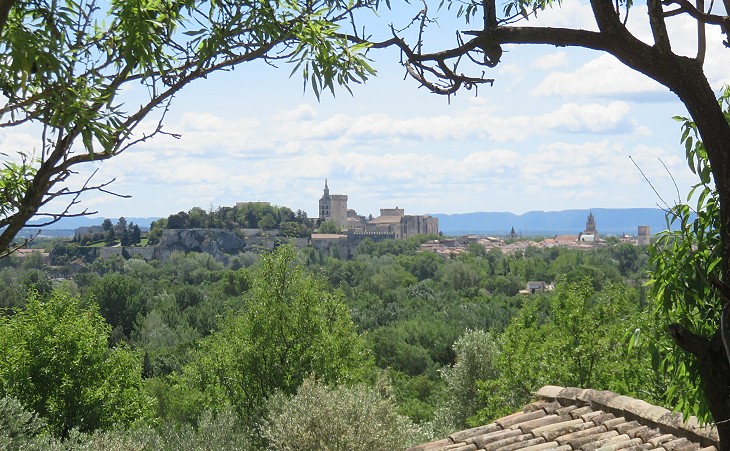
Avignon seen from Fort Saint-André at Villeneuve-lez-Avignon
The city is on the
Rhone, and divided from the newer part, or town, which is on the other side of the river, by a very fair stone bridge
(which has been broken); at one end is a very high rock, on which is a strong castle well furnished with artillery.
John Evelyn's Diary and Correspondence in 1644
This is a very ancient city,
said to have been founded by the Phoceans, who
built Marseilles. The Romans called it Avenio
Cavarum, and favoured it for its fidelity, with
great privileges.
Thomas Nugent - The Grand Tour - 1749
The site of the first Gallic settlement was a calcareous rock (Rocher des Doms) on the left bank of the River Rhône. It was suited to shelter a river harbour and it attracted the attention of the Greek merchants of Marseille who established there a trading post. The name of the town had a root indicating water. The Cavari were a Gallic tribe mentioned by Strabo who says they lived at Avignon, Arausio (Orange) and Cabellio (Cavaillon). See an ancient relief found near Cavaillon and now in the Lapidary Museum of Avignon which depicts a boat carrying wine and olive oil on a river.

Roman stones behind the Palace of the Popes
Near the cathedral it is supposed there formerly existed a temple dedicated to Diana and that the church itself was once a temple dedicated to Hercules, a statue of that hero having been found there on the base of which was the following inscription HERCULI AVENNICO DEO POTENTI PROTECTORI.
Tobias Smollett - Travels through France and Italy - 1766.
Ancient geographers referred to Avenio as a very florid city, but its Roman monuments have entirely disappeared. Those on the rock were most likely destroyed in 737 by the troops of Charles Martel who took the town from the Moors and razed it to the ground.
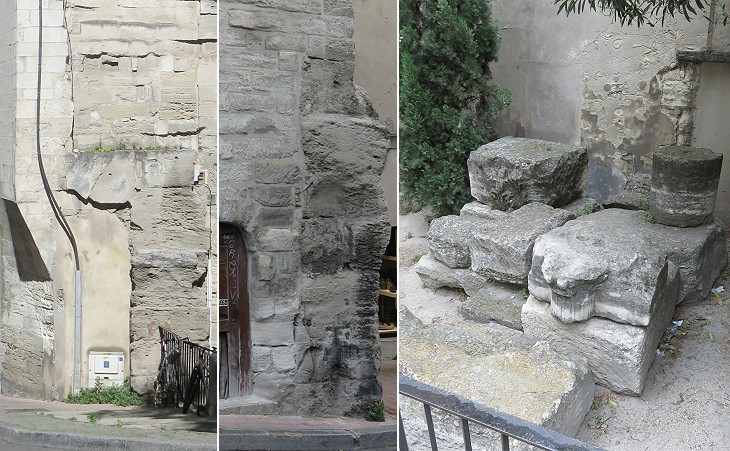
Ruins of the Roman Forum near Saint-Agricole
The Roman town at the foot of Rocher des Doms was already abandoned in the early VIIIth century. Therefore its buildings were not incorporated into medieval ones which might have saved some of their structures, but were quarried or were carried away by the frequent floods of the River Rhône. Excavations of deep foundations for modern buildings have unearthed evidence of Roman terraced areas, houses and the site of the Forum.

Lapidary Museum of Avignon in the former Jesuit church: a hall with an altar from Vaison-la-Romaine
M. Calvet has a fine Collection of statues, medals and ancient gems.
William Coxe - Galignani's Traveller's Guide Through France -1819
In the Rue Calade is situated the Musee founded by Calvet, a native of Avignon. Its collections are of considerable interest. The Roman antiquities found in the neighbourhood are numerous though few are derived from Avignon itself, the ancient Avenio.
John Murray III - Hand-book for Travellers in France - 1843
In 1933 the archaeological collections of the museum founded by Esprit Calvet (1728-1810) were moved to a former Jesuit church. See other French churches housing archaeological collections at Vienne and at Narbonne.
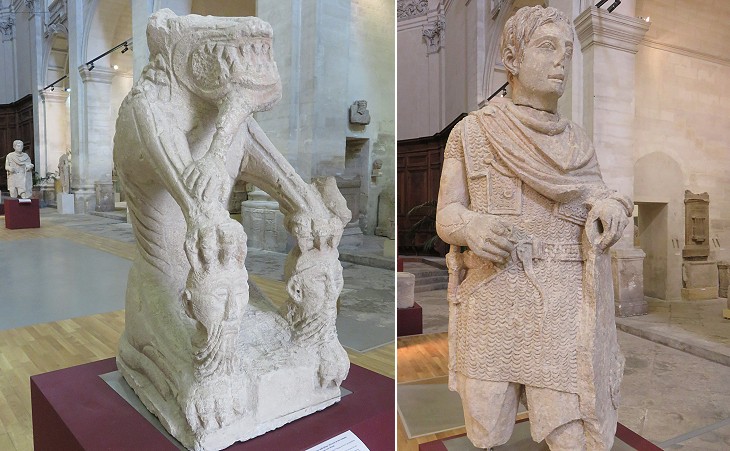
Lapidary Museum of Avignon: Gallo-Roman sculpture: (left) "Tarasque", a man killer monster, found in 1849 at Noves, south of Avignon and on the right bank of the River Durance, a tributary of the Rhône; (right) statue of a Gallic Warrior found in 1850 at Vachères, east of Avignon
The museum houses many interesting items which were found in the Department of Vaucluse of which Avignon is the capital since 1793. Some of them are a mix of classical and local cultures. The "Tarasque" was found at a location which was known for being a dangerous ford and it might have been a sort of warning; its iconography cannot be associated with any of the classical monsters, although its actions bring to mind Scylla, a sea monster; the name by which it is known refers to the monster of a medieval legend related to Tarascon, another town on the left bank of the Rhône, south of Avignon (see this monster in a modern statue).
The statue of a warrior is dated late Ist century BC and it might portray a soldier who served under Emperor Augustus, but some details of his armour and weapons are not Roman, so he might have belonged to a regiment of auxiliary troops.

Lapidary Museum of Avignon: (left) funerary urn from Tuscania depicting Eteocles and Polynices, the two sons of Oedipus who killed each other, between two Vanths (IInd century BC); (right) funerary urn from Rome of a master and his "verna", a slave who was born within his household (Ist century AD)
The exhibits of the museum include some items which are not related to Avignon and its environs, but which were bought on the international antiquarian market, including a fine funerary urn from Aquileia.
Entering the gates, the soldiers at the guard took our pistols and carbines, and examined us
very strictly; after that, having obtained the Governor's
and the Vice-Legate's leave to tarry three days, we were
civilly conducted to our lodging. Evelyn
The Pallace of the Popes is ancient and very spatious,
with many handsome Romes, where wee saw the Cabinet
that the Queene of Sweethland lay in when she was at
Avignion. The great Hall, which is alwaye full of the
Attendants of the Vice Legat, is painted all about with
the Pictures of the former Popes, wherein also is a very
faire Chappel, where was at the tyme that wee were there
the Vice Legate at Masse. Mortoft
In 1342 Pope Clement VI promoted an enlargement of the palace which was completed in 1352. The overall aspect of the complex was not modified by the Popes after that date. The main entrance with its two hexagonal turrets was damaged in 1770 when
on the 11th of June the French dragoons appeared before the gates of the pope's palace at Avignon, removed the old Swiss guards, kicked open the gates with their jack boots and entered the palace in triumph where the marquis de Rochevard in great state received the homage of the people in the name of the king Louis XV his master and caused the arms of France, which he had brought with him, to be affixed over the city gates.
The ancient Palace of the Popes now degraded into a barrack and prison is magnificent from its vastness in spite of its present degradation and mutilations and partakes of the mixed character of a feudal castle and convent. (..) The first court is disfigured by new buildings. Murray
As a succession of popes resided here for the space of seventy years, the city could not fail to be adorned with a great number of magnificent churches and convents, which are richly embellished with painting, sculpture, shrines, reliques, and tombs. Smollett
For ten years Religion was banned
and the Revolutionary Government systematically fought
every symbol of faith. After this period the knowledge
of having destroyed masterpieces of art and memories of the past
prevailed, but very little was left. Coxe
Some fine frescoes in the rooms of the Papal apartment were whitewashed rather than destroyed and restorers have brought them back to their original aspect. In order to preserve them ordinary visitors are not permitted to take photographs. This is allowed for some frescoes which are less interesting from an artistic viewpoint, but testify to the long history of the building. The position of Papal Legate of Avignon was a highly prestigious one and it was held by important members of the Papal Court, very often close relatives of the Pope. In the late XVIIth century however, because of the continuous rifts with King Louis XIV, the position was abolished and the administration of the town was entrusted with a Vice-Legate, a sort of partial acknowledgement of a weaker suzerainty of the Papal State.
The cathedral dedicated to the Virgin Mary, is a noble structure remarkable for its great altar, the tombs of several
popes and bishops, and for the chapel of our
Lady, which is admirably well painted. The
treasure of the Sacristy is worth a traveller's curiosity. Nugent
We seek in vain for the tombs of the popes. (..) The cathedral or metropolitan church of Notre Dame de Dom before the revolution contained many remarkable tombs and sculptured bas reliefs. Coxe
Avignion is (..) seated upon
the Rosne, where is a very faire Bridge, but some part
broken downe, soe that noe horse can goe over it. Mortoft
The legend says that Bénézet
enforced his preaching by miracles, and
raised such a sum as proved sufficient not
only to complete that undertaking, but also
to endow a hospital, and create a fund for
the future repairs of the bridge. Whatever
we may think of the miracles of this young
architect, the chronicles of Avignon attest
the reality of his existence: perhaps the
artful magistrates, seeing the necessity of a
bridge, and conscious of their own inability
to erect one, brought forward this pious artifice to captivate the benevolence, and excite
the generosity of a devout and unenlightened
age. This bridge was the boast of the country, but the Rhone has long torn down and
buried in its whirlpools the greater part of
it; at present a perilous ferry affords the
only access from the western shore. Swinburne
It is full of wellbuilt palaces; those of the Vice-Legate and Archbishop
being the most magnificent. Evelyn
The mint now occupied by the gendarmerie is opposite the principal entrance of the palace. Coxe
The Roman Monte di Pieta was founded in 1539 and a branch was opened at Avignon in 1610. A small museum retains some documents of its activity.
The walls of the city are of large square free-stone, the
most neat and best in repair I ever saw. Evelyn
The vices of an ecclesiastical government always fluctuating and ephemeral, operate
even at this distance to the discouragement
of industry, trade, and population: the inhabitants scattered over the face of one of
the richest plains in the universe, are not
sufficiently numerous to cultivate it thoroughly; trade is not carried on with that
emulation and activity, which ought to be
inspired by the proximity of so noble a river,
and so happy a situation, in the center of a
fertile country, and upon the great roads of
communication between the Mediterranean
and the capital of France. Smuggling indeed is pursued in a very spirited manner
with the adjacent provinces, but whether to the real advantage of the Comtat or not, is
hard to determine: it either encourages idleness, or diverts the attention of the active
part of the community from labours that
would redound more to their own happiness,
and the welfare of the state. But can it be expected that an Italian prelate and his crew
of subaltern priests, should feel themselves
sufficiently interested in the prosperity of a
country, where their power is short lived,
and which they always consider as foreign
to them, to meditate, much less to execute
projects for its amelioration?
These and other reasons have led many
speculators in politics to think, that the people
of the Comtat would be great gainers, were
the king of France to set aside the deed of sale
by queen Joan, and incorporate it unalienably with the rest of his kingdom. I am
clearly of another opinion; for what would
the people gain? More neighbours to fill
their plains and increase their culture; greater crowds on their roads, and clamour on
their wharfs, more bustle in their streets,
and more activity in their husbandry, some
of their families would be illustrated by dignities and titles, and some enormous fortunes raised by trade, or the handling of the public revenue. But with all these benefits,
allowing them their highest value, must they
not receive a swarm of devouring locusts,
an army of tax-gatherers and monopolisers?
Must not their taxes be prodigiously augmented, their salt, their tobacco, raised to
such a price as to exclude the poorer class of
citizens from a daily enjoyment of them?
Must they not submit to the peremptory
sway of intendants, subdelegates, military
governors, and a long train of oppressive
ministers, instead of the drowsy, but mild
administration of their present masters, who
want the power, if not the will, of raising
more than the stipulated contributions? The
inhabitants are too few for the extent of
country, are indolent, and do not make the
most of the riches nature presents on every
side: I grant it, but they are already entitled to all the privileges of Frenchmen, if
they choose to claim them, and at the same
time they enjoy almost the independence of republicans. The first necessaries, and many
of the superfluities of life, are cheap here;
impositions are few and light; the husbandman is not dragged from his plough to garrison unwholesome fortresses, or pine in the
cold and wet, to guard a coast against invaders: no districts are here reserved for the
diversion of their sovereign, nor are their
harvests devoured before their eyes by myriads of useless animals, which it is a capital
offence to destroy, or even to molest. Then
where shall I find a set of men that possess
such means of happiness as the cultivators
of this delicious plain?
Move to see Other Monuments of the Town.
Plan of this section: - The City of the Popes
- The City of the Popes
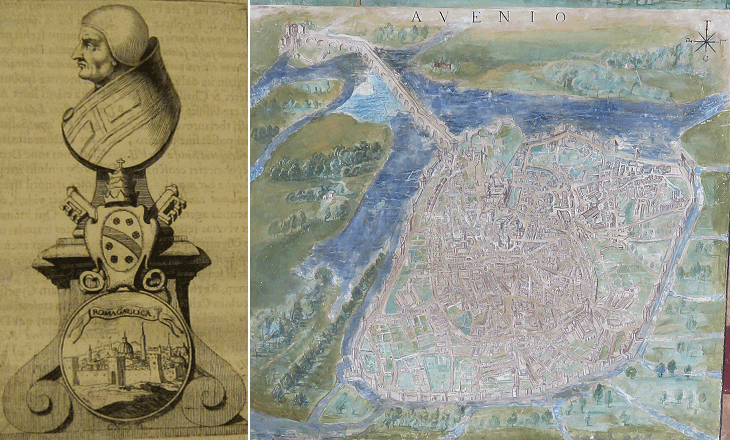
(left) Pope Clement VI in a plate from "G. Palazzo - Gesta Pontificum Romanorum - 1688" (the view of Avignon/Roma Gallica can be seen in the image used as background for this page); (right) Map of Avignon in a 1580 fresco at Galleria delle Mappe Geografiche in the corridors of Palazzo del Belvedere in Rome
There is a continual Guard
at the gate, which examins all persons that enter into the
Citty, what they are, and whether they are of the reformed
Religion, Not one Protestant being suffered to dwell
in the Towne, or to remaine there more then 8 dayes.
Francis Mortoft's Journal of his travels in France and Italy in 1659
You know Avignon is a large city belonging to the pope. It was the Avenio Cavarum of the antients, and changed masters several times, belonging successively to the Romans, Burgundians, Franks, the kingdom of Arles, the counts of Provence, and the sovereigns of Naples. It was sold in the fourteenth century (in 1348), by queen Jane I. of Naples, to Pope Clement VI. for the sum of eighty thousand florins, and since that period has continued under the dominion of the see of Rome. Not but that when the duc de Crequi, the French ambassador, was insulted at Rome in the year 1662, the parliament of Provence passed an arret, declaring the city of Avignon, and the county Venaissin part of the ancient domain of Provence; and therefore reunited it to the crown of France, which accordingly took possession; though it was afterwards restored to the Roman see at the peace of Pisa. The pope, however, holds it by a precarious title, at the mercy of the French king, who may one day be induced to resume it, upon payment of the original purchase-money. Smollett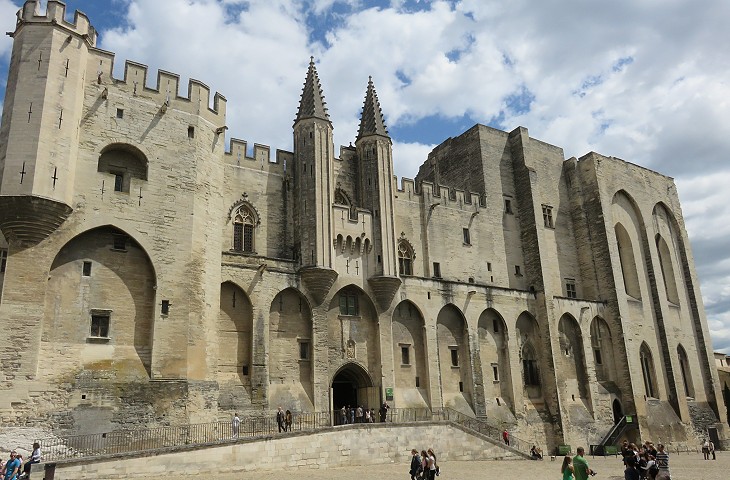
Papal Palace
Pope Clement V (Raymond Bertrand de Got, Archbishop of Bordeaux) was anointed in the Cathedral of Lyon in 1305 and he chose not to reside in Rome. He lived at Poitiers and other towns of France on a temporary basis until in 1313 he moved to Carpentras in the Comtat Venaissin, a region east of Avignon, which had been bequeathed to the Holy See in 1274 and which today makes most of the Department of Vaucluse. In 1316 Pope John XXII set his permanent residence at Avignon in the episcopal palace and in 1335 Pope Benedict XII began the construction of a new fortified palace which was completed in 1341.
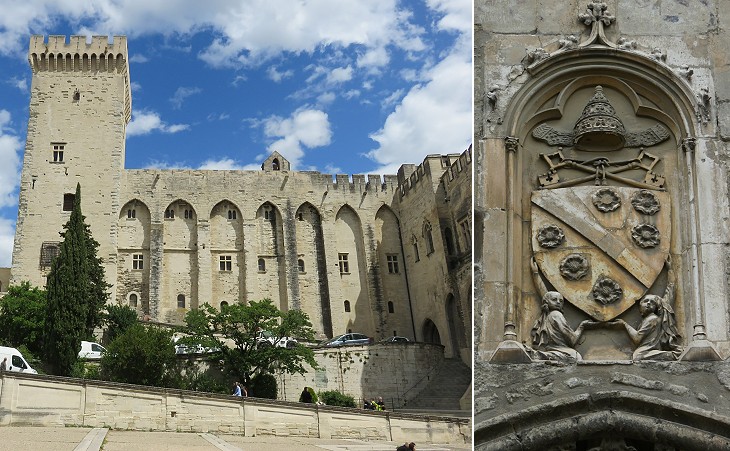
(left) Western end of the front with Tour de la Campane (first phase - restored in 1902); (right) coat of arms of Pope Clement VI above the main entrance
William Jones - The History of Modern Europe - 1839
Avignon was returned to the Pope in 1774, but worst was to happen after the town was annexed to France in 1791, during the French Revolution.
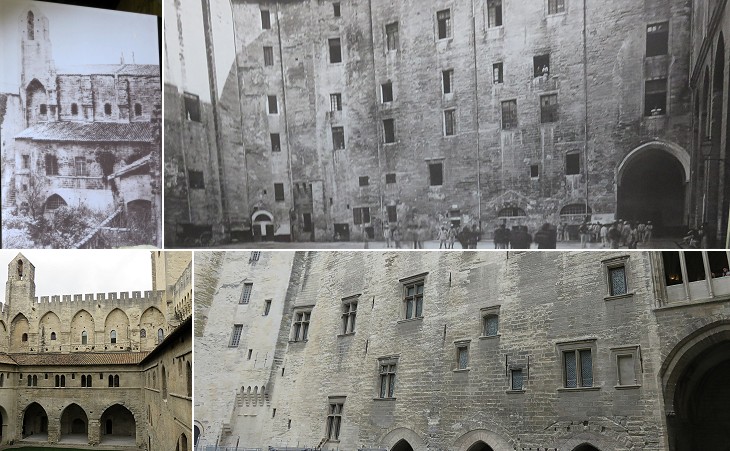
(above) Interior of the palace in the late XIXth century; (below) as it is today
Of the ancient Palace of the Popes one portion is now a common jail, and another a noisy
barrack: while gloomy suites of state apartments, shut up and
deserted, mock their own old state and glory, like the embalmed
bodies of kings. (..) We dropped some
money into a prisoners' box outside, whilst the prisoners,
themselves, looked through the iron bars, high up, and watched us
eagerly. (..) The recollection of its
opposite old uses: an impregnable fortress, a luxurious palace, a
horrible prison, a place of torture, the court of the Inquisition:
at one and the same time, a house of feasting, fighting, religion,
and blood: gives to every stone in its huge form a fearful
interest, and imparts new meaning to its incongruities.
Charles Dickens - Pictures from Italy - visit made in 1844.
Pope Pius VI acknowledged the annexation of Avignon to France in the Treaty of Tolentino in 1797 and as a consequence the Palace of the Popes was partitioned and utilized in various manners by French authorities.
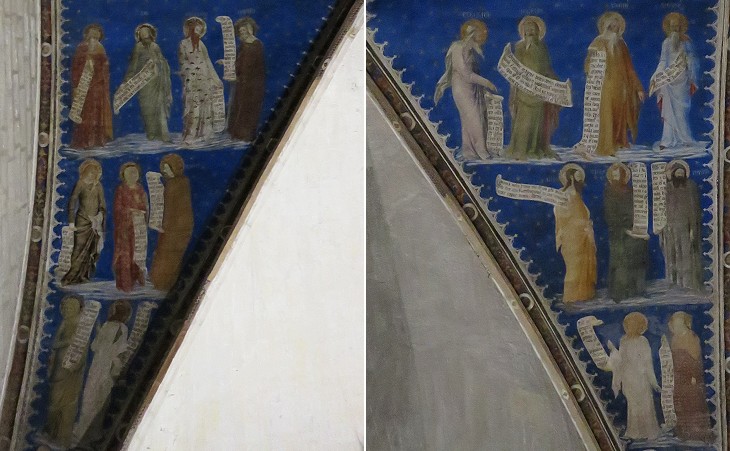
Frescoes portraying Prophets by Matteo Giovannetti in the Great Audience Hall
The soldiers detach the heads painted by Giotto on the walls and they sell them to the rich of Avignon.
Stendhal - Memoirs of a Tourist - 1838.
Side chapels and the Salle du Consistoire have traces of frescoes executed in the 14th century, but they are partly effaced or concealed from view by the modern division of this lofty range of halls by floors into 3 stories to convert them into dormitories. (..) The Chapelle du Saint Office vaulted and groined still retains some of the frescoes with which it was decorated by Giottino (actually Matteo Giovannetti, a painter from Viterbo) pupil of Giotto; a large portion including the Last Judgment is so much effaced as scarcely to be distinguished, but figures of prophets &c have escaped. Murray
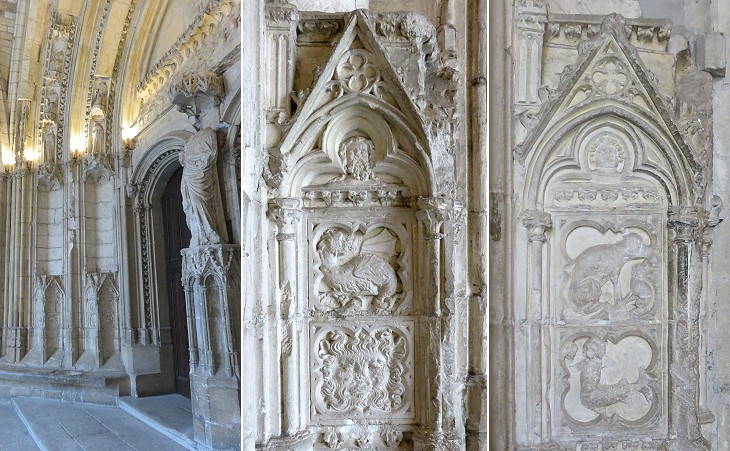
Portal of the Grand Chapelle: the statues were destroyed or beheaded, but the small reliefs portraying fantastic animals were spared, similar to what occurred to those of the Cathedral of Lyon which have the same frames
The French Army left the Palace in 1906. In more than a hundred years of occupation the military had turned it into a barracks which was undistinguishable from all the other barracks according to a local historian who wrote in 1909. A lengthy process of restoration and more often of reconstruction began. It was based on past descriptions, paintings and engravings. In 1995 UNESCO inscribed the Papal Palace and the adjoining monuments in the World Heritage List (with many "despite"): Overall, despite the accidents of history, the edifices that comprise the Historic Centre of Avignon have retained sufficient authenticity to enable the appreciation of the architectural coherence and to express the Outstanding Universal Value that it represents.
The Papal Palace, despite many alterations, has regained a certain authenticity thanks to various restoration campaigns that enabled, among others, the safeguarding of the priceless painted decor of the Papal apartments and the Saint-Martial Chapel. The Episcopal Palace had an identical destiny, while the cathedral, despite transformations during the Baroque period, has preserved its architectural integrity.
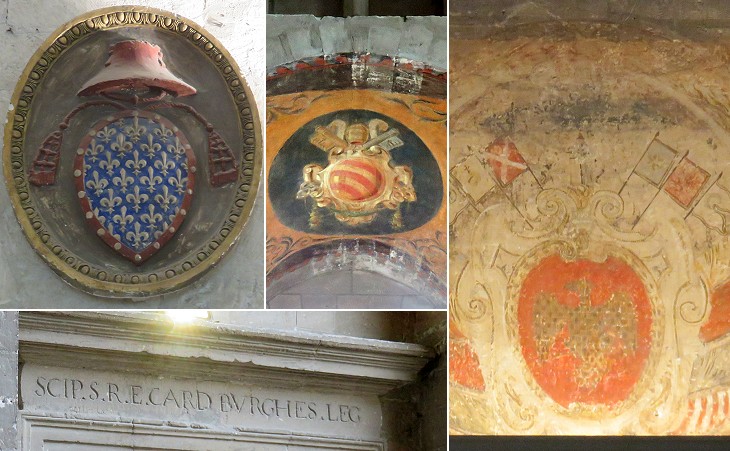
Coats of arms of: (left) Cardinal Philippe d'Alençon who was buried at S. Maria in Trastevere in 1397; (centre) Pope Pius V; (right) a Vice-Legate of the Conti family, perhaps Giannicolò, uncle of Pope Innocent XIII; (left-below) inscription making reference to Cardinal Scipione Borghese
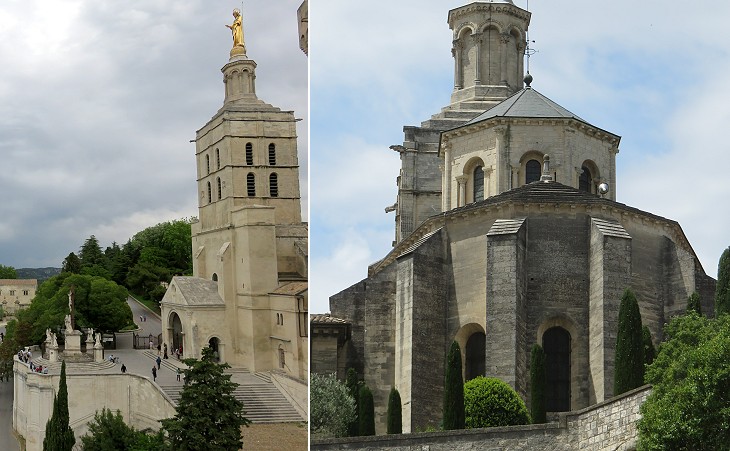
Cathedral Notre-Dame des Doms: (left) front; (right) apse
The public edifices are large, solid, and as
grand as the taste of the age could make
them, for most of them were built in the
fourteenth century, while the Popes resided
here; they occupy the most elevated point
within the walls; the cathedral is small and
dull.
Henry Swinburne - Travels through Spain in the Years 1775 and 1776 to which is added a Journey from Bayonne to Marseille - 1787 Edition
The rear part of the Cathedral was built in the XIIth century, whereas the bell tower was erected in 1341. The gilded statue of the Virgin Mary was added in 1859.
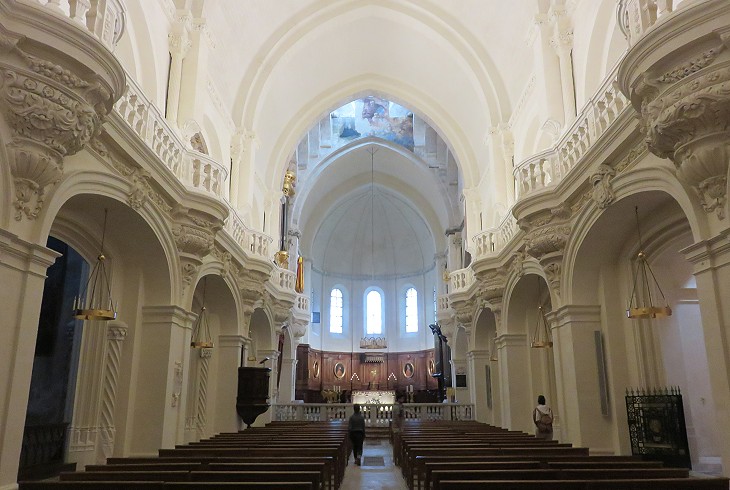
Cathedral Notre-Dame des Doms: interior redesigned in the 1670s
Besides what it suffered at the Revolution this edifice was in 1814 made the receptacle for some hundred Spanish prisoners. It has lately undergone repairs and has been modernised with bad effect. Murray
We went, first of all, up a rocky height, to the cathedral: where Mass was performing to an auditory of several old women, a baby, and a very self-possessed dog. (..) It is a bare old church, and the paintings in the roof are sadly
defaced by time and damp weather; but the sun was shining in,
splendidly, through the red curtains of the windows, and glittering
on the altar furniture; and it looked as bright and cheerful as
need be. Dickens
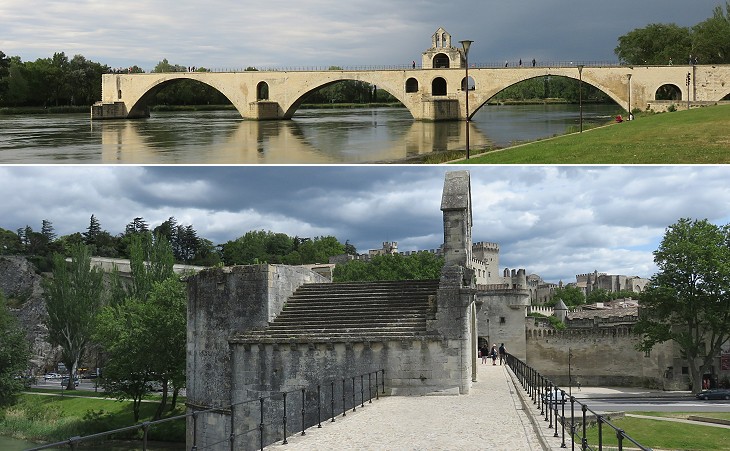
Pont Saint-Bénézet: (above) seen from downstream; (below) seen from its end; see Papal Avignon from Pont Saint-Bénézet in the introductory page
The Rhone is here seen rolling its animated stream through meadows covered with olive trees and at the foot of hills invested with vineyards. The ruined arches of the old bridge carry the imagination back into the ancient history of the town. On the opposite side of the town are the sunny plains of Languedoc which when refreshed by the wind breathe odours and perfumes from a thousand wild herbs and flowers. Coxe
The spires of Avignon and the gigantic towers of the Papal palace now rise conspicuously to view. (..) The steamers stop at the quay outside the lofty battlemented city wall just above the broken stone bridge of St Benezet and its little chapel which is about a mile from the Inns. Passengers are left in the hands of the porters of Avignon who are notoriously a brutal set and whose exactions and insolence ought to be repressed by the police. Murray
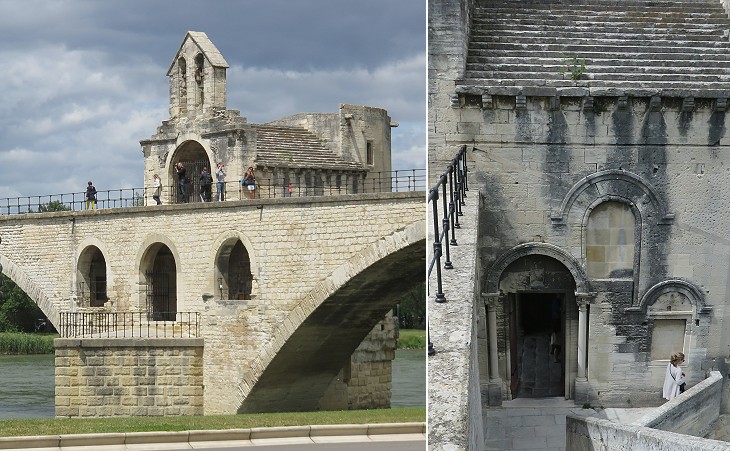
Pont Saint-Bénézet: (left) pillar with two chapels; (right) lower Romanesque chapel
There is no evidence that the Romans built a bridge at Avignon, although there might have been a pontoon-bridge; the town was not situated on a main east-west road and transportation needs could be coped with by ferries. The bridge was built in the XIIth century and it is named after Bénézet, a young shepherd who had a vision in which he was told to build a bridge across the Rhône. In 1669 a major flood destroyed most of the arches sparing only four of them on the left bank. It was never rebuilt; its remarkable length can be seen in the fresco at the top of the page.
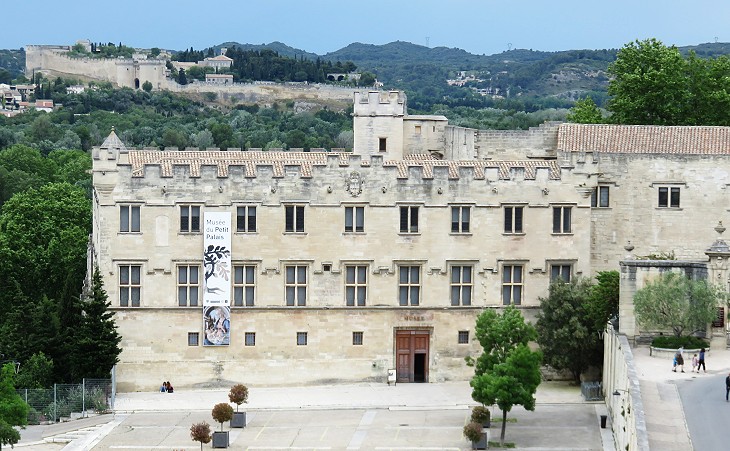
Petit Palais and Fort Saint-André at Villeneuve-lès-Avignon in the background
The little palace belonging to the archbishop is a handsome structure, from whence there is a beautiful prospect: of the town, the Rhone, and the neighbouring country. Nugent
The ancient episcopal residence was at the end of the palace and contained some noble apartments. Coxe
This small palace was built in 1317 and it was redesigned in 1474 at the initiative of Cardinal Giuliano della Rovere, nephew of Pope Sixtus IV. After Avignon was annexed to France its interior was modified in order to use it as a seminary and after 1905 as a secondary technical school. In 1960 it was bought by the City of Avignon which turned it into a museum of paintings. 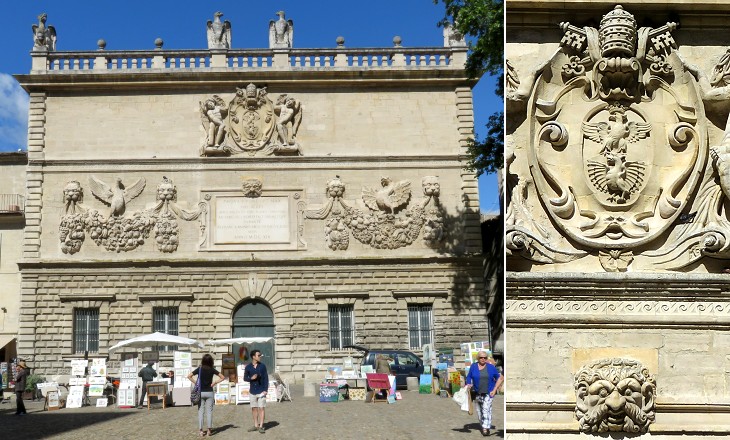
(left) Palais de la Monnaie (Mint Palace); (right) coat of arms of Pope Paul V
The modern building facing the Papal palace now Caserne de Gendarmerie fantastically ornamented in front with large garlands carved in stone was the Papal mint. Murray
Palais de la Monnaie was built in 1619 during the pontificate of Pope Paul V and its façade was decorated with his coat of arms and heraldic symbols (eagles and dragons). These were destroyed after the annexation of Avignon, but they have been remade.
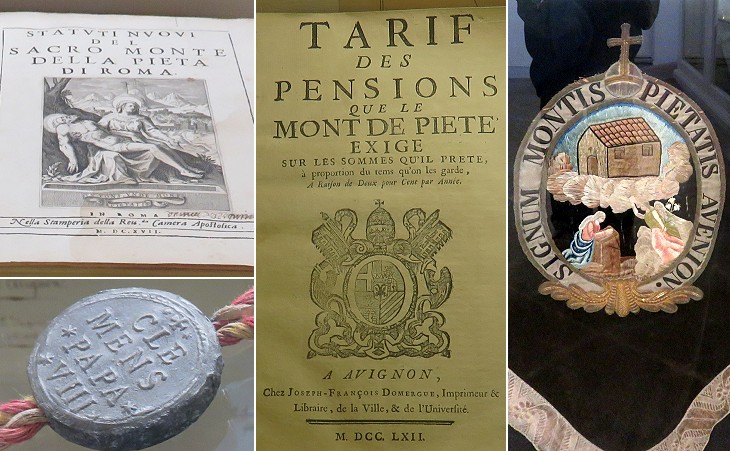
Musée du Mont-de-Piété: (left-above) 1617 statute of the Roman Monte di Pieta; (left-below) seal of Pope Clement VIII; (centre) terms of lending in 1762 at the time of Pope Clement XIII; (right) standard of the institution for processions
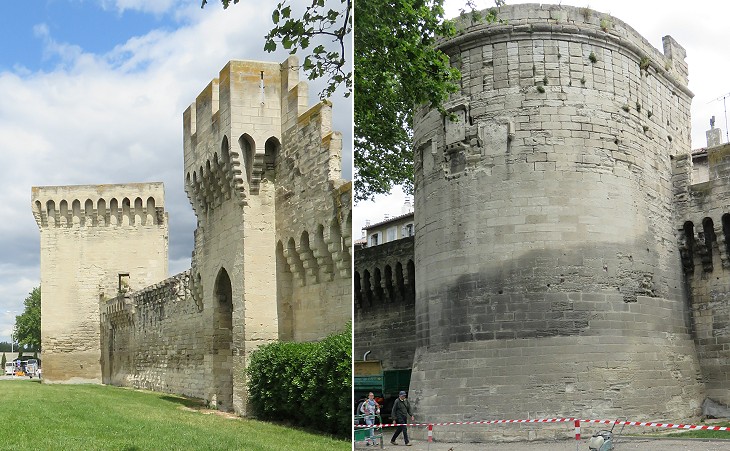
(left) Walls along the river; (right) a bastion with frames which housed papal coats of arms which were erased by French troops as it occurred at Castel Sant'Angelo in Rome
Avignon is about three miles and
two furlongs in circumference, surrounded by handsome battlemented walls and
turrets. Swinburne
The walls were built in 1356-1370, but they had an almost decorative purpose, because the Popes relied on their palace/fortress for their protection. Apart from very few towers they were not upgraded to the needs of cannon warfare. The Popes were aware that they could not militarily defend the town if the Kings of France decided to conquer it, which they actually did in 1662, 1668 and 1770. It was by diplomacy and by threatening excommunications that they managed to retain the town until 1791.
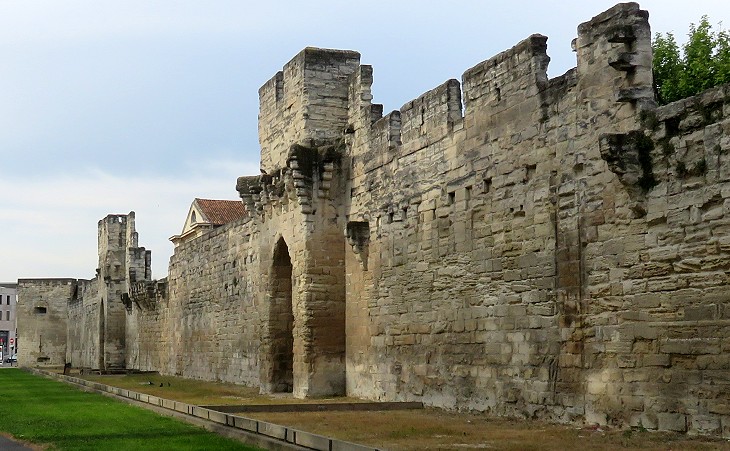
Walls near Porte Saint-Lazaire which are less restored than those along the river
An Opinion on the Papal and French Governments by H. Swinburne
Introductory page
Arles (Arelate)
Environs of Arles: Saint-Gilles, Aigues-Mortes and Saintes-Maries-de-la-Mer
Avignon (Avenio)
Carpentras (Carpentaracte), Cavaillon (Cabellio) and Pernes-les-Fontaines
Fontaine-de-Vaucluse and Le Thor
Glanum
Lyon (Lugdunum)
Marseille (Massilia)
Narbonne (Narbo Martius)
Nîmes (Nemausus)
Orange (Arausio)
Pont-du-Gard and Uzès
Saint-Bertrand-des-Comminges (Lugdunum Convenarum)
Tarascon (Tarasco)
Toulouse (Tolosa)
Vaison-la-Romaine (Vasio)
Vienne (Vienna)
Villeneuve-lez-Avignon

